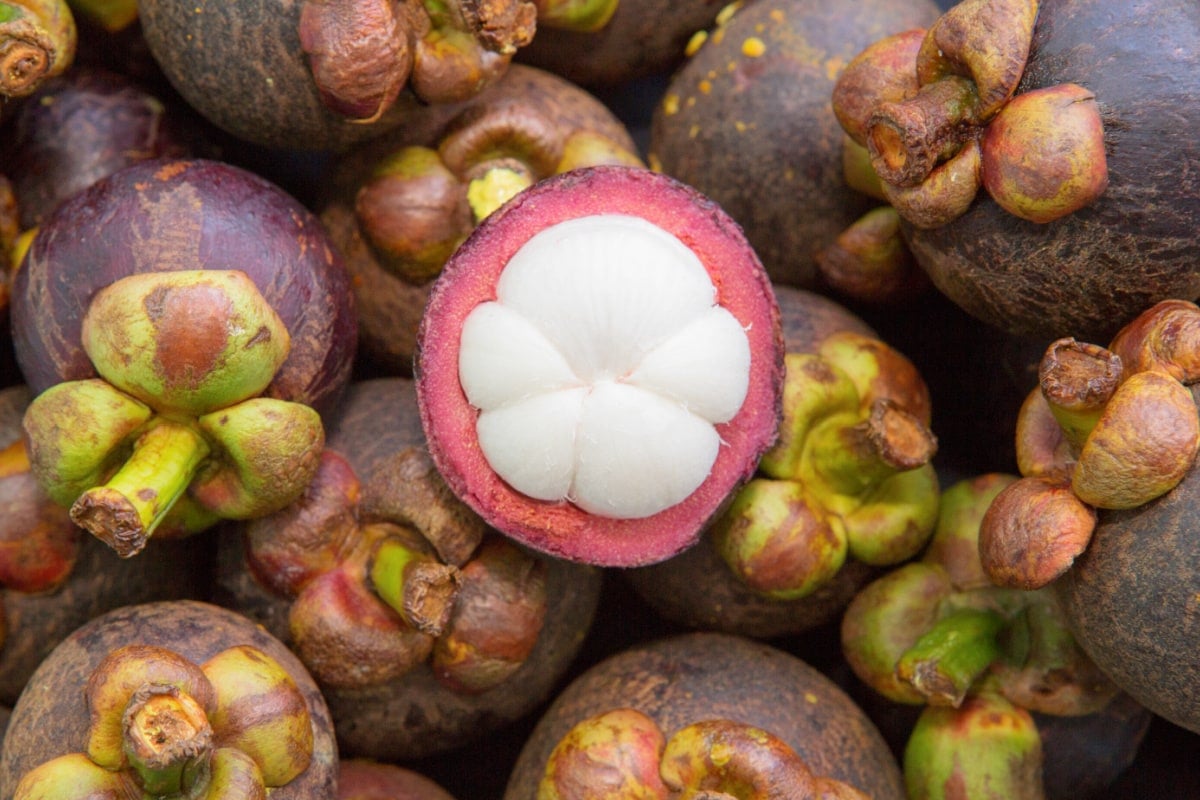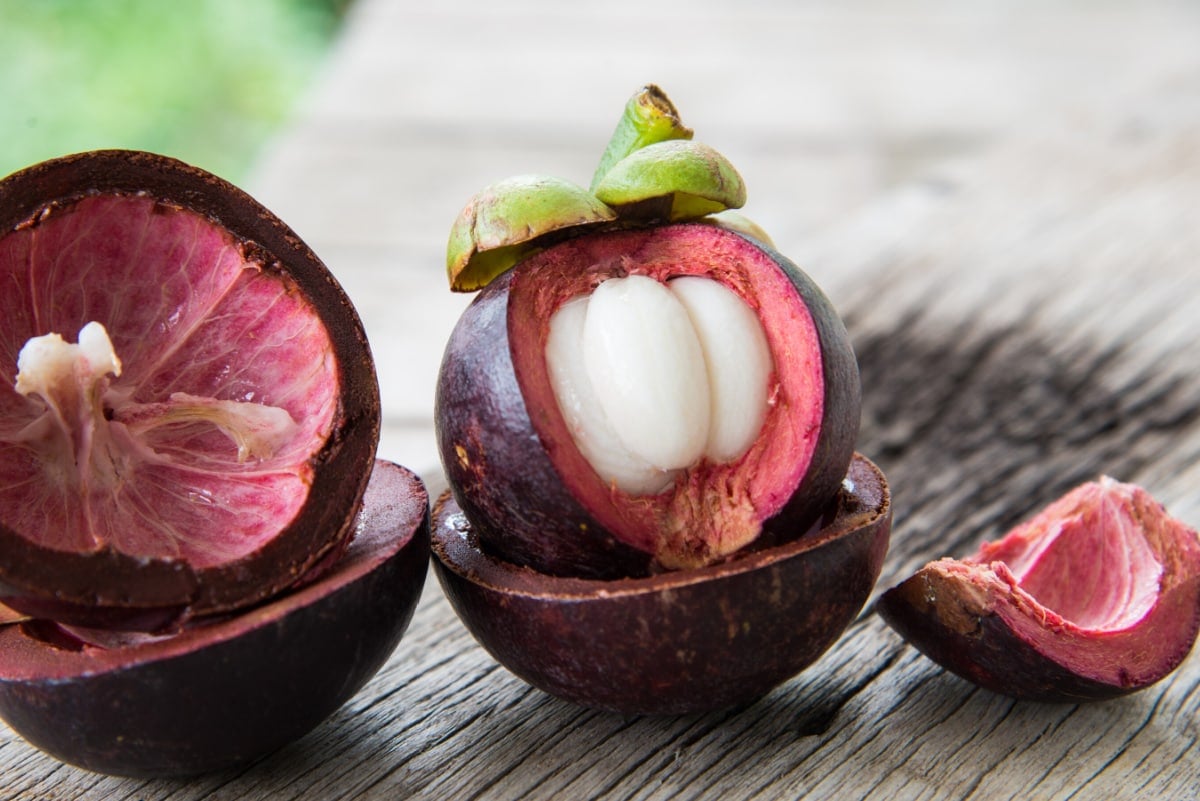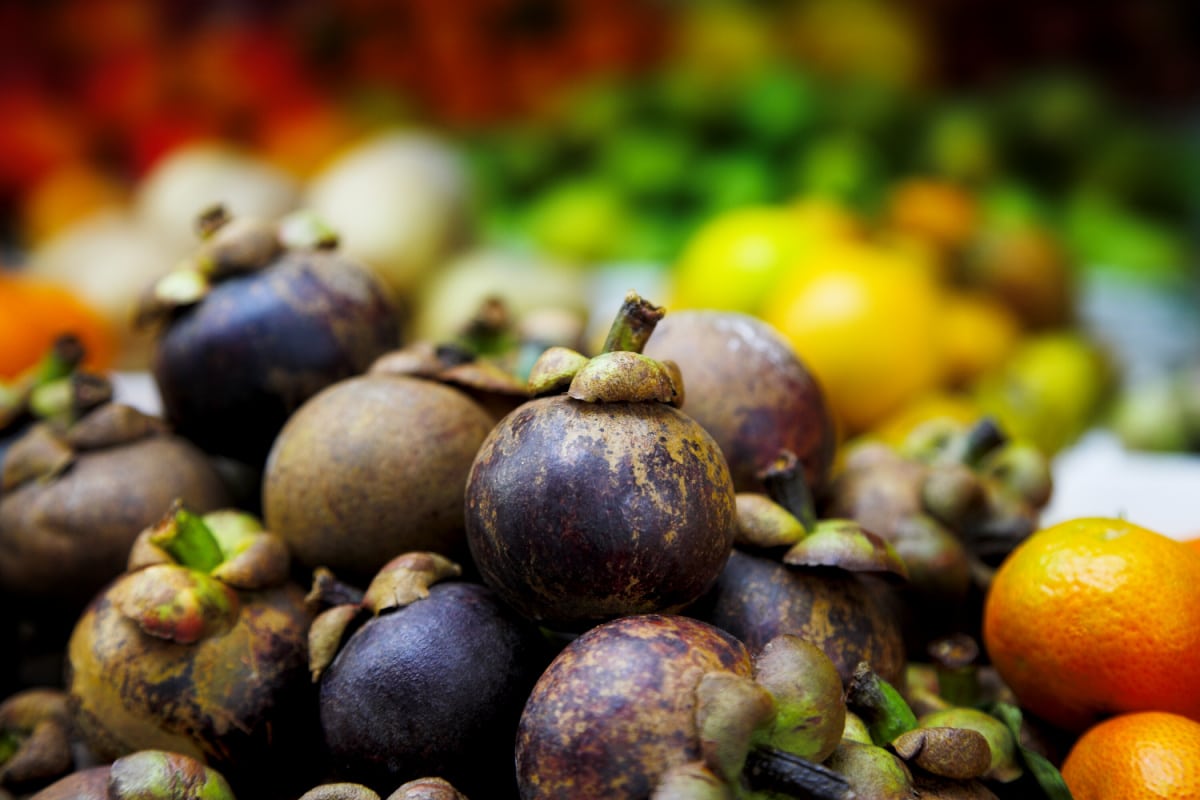Mangosteen Benefits
Mangosteen is a small purple colored fruit that grows in Southeast India. In recent years this fruit has gained a lot of popularity, and the various mangosteen benefits have actually given the fruit a reputation for being a superfood!
Mangosteen has a sweet and sour taste as a mix of peach, strawberry, and lychee. This fruit is also known as purple mangosteen due to its deep purple color. This color is developed when the rind is ripened. In contrast, the inner of this fruit is juicy and bright white.
I also love other exotic fruits like Loquat, Tuna Fruit, Bread Fruit, and Ackee!
What Is Mangosteen?
Mangosteen, scientifically known as Garcinia Mangostana, is a tropical fruiting tree. It is cultivated in Malaysia, Sri Lanka, Indonesia, and the Philippines. Other tropical countries also grow and consume this fruit as juice or medicine.
The original place where this fruit first originated is not well known, but some evidence has found its presence in the Moluccas and Sunda Island.
These wild trees can be found in Malaya and Kemaman forests. It is also cultivated in Vietnam, Burma, Thailand, and Southwestern India.
Many attempts have been made to cultivate this tree in U.S, but have had limited results. Therefore, fresh mangosteen is hard to find in the United States.
There are two reasons for that. First, mangosteen trees need a full tropical environment and a lot of time to grow. Second, fresh mangosteen can increase the risk of pests or bugs that can threaten the ecosystem, which makes it necessary for the importers to sterilize the fruit before it enters the country.
The mangosteen tree has very slow growth. This tree can grow between 6-25 m in height. It has a short stalk and dark green leaves, which are yellow-green on the underside.
The fruit of this tree is round and dark purple in color. The flesh of the fruits is bright white and juicy, with or without seeds.
What Does Mangosteen Taste Like?
Mangosteen fruit tastes sweet and juicy with a hint of tartness. It is known for its unique and delicious flavor.
It is often described as having a sweet and tangy taste, with notes of citrus, peach, and strawberry. The flavor is complex, with a delicate balance of sweetness and acidity. In fact, it reminds me of a sweet version of soursop.
One of the distinctive characteristics of mangosteen is its aromatic fragrance, which is often compared to a combination of tropical fruits like pineapple, mango, and citrus.
It’s worth noting that the taste and flavor of mangosteen can vary slightly depending on the ripeness and quality of the fruit.
Ideally, you want to choose mangosteens that have a deep purple or reddish-purple rind, indicating they are ripe and ready to eat.
Mangosteen is highly regarded as a delicious and sought-after fruit, often referred to as the “queen of fruits” due to its exceptional flavor.
How to Eat Mangosteen?
Eating mangosteen can be a delightful experience. Here’s a step-by-step guide on how to eat mangosteen:
- Select a ripe mangosteen: Look for mangosteens with a deep purple or reddish-purple rind. The rind should be firm and smooth without any blemishes or signs of mold.
- Prepare the fruit: Hold the mangosteen firmly and use a sharp knife to make a shallow cut through the thick rind around the circumference of the fruit. Be careful not to cut too deep to avoid piercing the segments inside.
- Twist and open: Hold the fruit with both hands and gently twist the two halves in opposite directions. The rind should separate easily, revealing the creamy white segments inside.
- Remove the segments: Using your fingers or a small spoon, gently pry out the individual segments from the rind. Each segment contains a fleshy, edible aril surrounding a seed.
- Enjoy the fruit: Pop the juicy segment into your mouth and savor the delicious flavor. The aril is the edible part, while the seed is typically discarded.
- Repeat and enjoy: Continue removing and eating the segments until you have enjoyed all the ripe fruit.
It’s important to note that mangosteen can be juicy, and the rind contains a purple pigment that can stain clothing and surfaces, so it’s advisable to handle it with care and be mindful of where you eat it.
Mangosteen is best enjoyed fresh and at room temperature. Its flavor and texture are highly regarded, so take your time to savor each segment and enjoy the unique taste of this tropical fruit.
Mangosteen Nutrition Facts:
Mangosteen is low in calories but contains a high amount of essential nutrients. One cup of canned mangosteen can provide:
- Calories: 143
- Carbs: 35 grams
- Protein: 1 gram
- Fat: 1 gram
- Fiber: 5 grams
- Vitamin C: 9% of the daily recommended value
- Magnesium: 6% of the daily recommended value
- Copper: 7% of the daily recommended value
- Folate: 15% of the daily recommended value
- Riboflavin: 6% of the daily recommended value
- Thiamine: 7% of the daily recommended value
- Manganese: 10% of the daily recommended value
These vitamins and minerals present within mangosteen are essential and play an important role in some major body functions like DNA production, wound healing, immunity, and muscle contraction.
Moreover, a single cup of this fruit can provide almost 14% of the daily recommended value of fiber, an essential nutrient which is not enough in most people’s diets.
Where To Buy Mangosteen?
The best way to find mangosteen is to look for it in the Asian market, but be aware of its price because fresh mangosteen can be expensive.
My daughter brought me 10 mangosteen fruits from the local Asian market. I was so happy when I saw these fresh purple mangosteen and I couldn’t wait to taste them. I was really impressed by how delicious mangosteen tasted.
If you are looking for fresh mangosteen, choose the fruit with a smooth rind with dark purple color. The rind of this fruit is not edible and can easily be removed with the help of a knife.
Fresh mangosteen can also be purchased online as well. It can also be found freeze-dried, as a powdered supplement, as juice, and canned (note that the canned version may contain added sugar).
Mangosteen Benefits:
Due to the high nutritional value of mangosteen, it can provide a lot of health benefits, including weight loss.
1. Rich Source of Antioxidants
Mangosteen has also gained popularity due to its unique antioxidant profile. Antioxidants are compounds that can cancel the damaging effect of harmful molecules known as radicals. These harmful molecules are associated with various chronic diseases.
Mangosteen consists of several nutrients with antioxidant properties like folate and Vitamin C. moreover; this fruit also provides Xanthones, a unique type of plant compound with strong antioxidant properties.
Several studies (Ovalle-Magallanes, 2017) have found that the antioxidant property of Xanthones can provide anti-inflammatory, anti-aging, antidiabetic, and anticancer effects as well.
Moreover, in another study of 60 people (Zhuohong Xie, 2015), 30 people were given the mangosteen beverage daily for a month. The researchers compared the blood of these people to the other 30 people who had consumed the beverages without mangosteen.
After a month, the researchers found out that the group of people with mangosteen beverages had more antioxidants in their bloodstream as compared to the placebo group.
2. Anti-Inflammatory Properties
Inflammation is a natural and normal part of the immune system, in which the body removes foreign substances like viruses, bacteria, and other chemicals. However, sometimes, this inflammation tends to continue even after removing the threat and can contribute to various health conditions like cancer, arthritis, depression, and heart diseases.
The anti-inflammatory properties of mangosteen can lower the risk of these inflammatory diseases. The xanthones present in mangosteen also play an essential role in reducing inflammation.
According to a test tube study (Ovalle-Magallanes, 2017), xanthone has anti-inflammatory properties and can reduce the risk of various inflammatory diseases like heart diseases, diabetes, and cancer.
Mangosteen also contains a large amount of fiber, which can provide various health benefits. According to an animal study (Vieira, 2017), a diet rich in fiber can help in reducing the inflammatory response of the body.
3. Promotes Weight Loss
One of the biggest reasons behind the popularity of mangosteen within a few years is its ability to promote weight loss.
This is because of the higher fiber content present in mangosteen. It can slow down digestion and make you feel full for longer, which means low-calorie intake and results in weight loss.
One animal study (Chae, 2016) of mice on a high-fat diet found out that the mice who received mangosteen supplements gained less weight as compared to the mice in the control group with no supplements.
Similarly, a small human study (Udani, 2009) found out that the people who take supplements of mangosteen juice twice daily with their diet have lower body mass index than the control group.
4. Anti-Cancer Effects
According to multiple research types, a diet with a high amount of vegetables and fruits like mangosteen can reduce the risk of various cancers.
This is due to the presence of xanthones in mangosteen, a specific plant compound with anti-inflammatory and antioxidant properties. These properties of xanthones can reduce the development and spread of cancerous cells.
According to a test tube study (Shan, 2011), xanthones can prevent the growth of cancer cells present in the breast, lung tissues, and stomach.
Moreover, in another small animal study (shan, 2011), one group of mice was given the mangosteen extract.
The study found the slow progression of colon and breast cancer in the mice with mangosteen extraction compared to the other mice without extract consumption.
5. Maintain Blood Sugar Levels
The plant compound present in mangosteen can be helpful in maintaining blood sugar levels as well. Both test tube and animal studies have shown this benefit of mangosteen.
For example, one study of obese women (Watanabe, 2018) found out that the women who took 400 mg of supplemental mangosteen extract daily had a significant reduction in insulin resistance compared to the control group.
Also, the fiber present in this fruit can also help in maintaining blood sugar levels. This is because the body can not easily break down fiber, which means no spike in the blood sugar occurs like other carbs cause. Moreover, fiber also reduces bad cholesterol levels, which is also a risk factor for diabetes.
6. Increase Immunity
Vitamin C and fiber present within mangosteen are important for a healthy immune system. Fiber supports healthy gut bacteria, which are also essential to a healthy immune system. Furthermore, vitamin C improves the function of various immune cells and also has antioxidant properties.
Some researchers (Cunha, 2014) have also shown that plant compounds that mangosteen contain have antibacterial properties as well, which can provide benefits when it comes to immune health by killing harmful bacteria.
The human immune system needs many different nutrients in order to function properly. And mangosteen can be a good choice, but keep other nutrient-dense food on the side in your balanced diet.
7. Maintain Healthy Skin
Skin exposure can cause skin damage, which is common worldwide and can cause the risk of many skin issues like cancer and aging.
One animal study (Im, 2017) of mice treated with mangosteen extract observed that these mice have a positive effect against ultraviolet-B radiation in the skin.
Moreover, another small 3-month human study (Ohno, 2015) found out that people treated with 100 mg of mangosteen extract daily have more elasticity in their skin and less accumulation of the compound that causes aging compared to the control group.
The main reason behind the skin protective effect of the mangosteen is its anti-inflammatory and antioxidant properties, which provide a protective effect on the skin.
8. Other Potential Benefits
- The fruit is rich in vitamins and minerals, Vitamin A, B6, C, thiamine, zinc, folate, potassium, calcium, riboflavin, niacin. Read More.
- Mangosteen can also have some positive effects on the brain and digestive system Read more.
- Digestive Health: One cup of mangosteen can provide almost 14% of the daily recommended value of fiber, which is essential for digestive health. Studies (Diane Quagliani, 2017) have also shown that a diet high in fiber can improve bowel movement. Read more.
- Mangosteen’s leaves and barks are used medicinally. Read more.
- Heart Health – the xanthone called Alpha-Mangostin in mangosteen are credited in reducing heart attack risk. Read more.
- Brain Health: mangosteen can be very helpful in improving brain health due to its anti-inflammatory properties. Studies(Oberholzer, 2018) have shown that mangosteen can be very helpful in decreasing brain inflammation and preventing mental decline and symptoms of depression.
Check Out More Exotic Fruits:
- Mangosteen
- Durian
- Eggfruit (Canistel)
- Soursop
- Granadilla
- Yellow Dragon Fruit
- Naseberry (Sapodilla)
- Black Sapote
- Guinep
- Guava
- Starfruit (Carambola)
- Yellow Passion Fruit
- Longan
- Cherimoya
Who Should Avoid Mangosteen?
Consuming mangosteen is safe for most people, but few face adverse health effects after consuming it in its whole form. Moreover, the other concentrated forms like juices, powder, and supplements are also not 100% risk-free.
Early research (Cordier, 2012) suggested that xanthones found in herbal supplements, including supplemented mangosteen, can slow down the process of blood clotting.
As mangosteen is a rich source of xanthones, it is not a good idea to consume this fruit or its supplements if you have a blood clotting condition or are taking medications like blood thinning.
There is not enough research available to ensure the safety of mangosteen supplements for pregnant and breastfeeding women. Therefore, while the fruit is fine for regular eating, it is probably better to avoid supplemental forms at this stage of life.
Moreover, consult your doctor or health professional before making any changes to your diet plan or taking any new supplements, including mangosteen supplements.
Conclusion on Mangosteen:
Mangosteen is a tropical fruit that originated from Southeast Asia and has gained popularity within the last few years due to its numerous health benefits. This fruit contains a large number of nutrients that are essential for the proper functioning of the body.
Most of the benefits of mangosteen are related to its antioxidant profile and plant compounds present. These antioxidants and plant compounds can help lose weight, maintain blood sugar levels, and reduce the risk of various chronic diseases like heart diseases and cancer.
Mangosteen can be easily added into the diet, as its juicy and sweet taste makes a delicious addition to food recipes. It is mostly used in smoothies and salads.
Fresh mangosteen is not easy to find, but the canned and supplemental forms are more common. Be aware of the canned mangosteen as it can contain added sugar in it.
Whether you use this fruit for culinary purposes or its health benefits, it is a win either way!
More About Fruits:
- Best Fruits for Heart Health
- Best Immunity Boosting Fruits
- Zinc Rich Fruits
- Best Fruits for Diabetics
- Dry Fruit Benefits
- Best Fruits for Backpacking
- Fruits to Eat During Pregnancy
- Best Fruit for Eye Health
If you enjoyed this post about Mangosteen Benefits and would love to see more, join me on Youtube, Instagram, Faceboo
Join Our Facebook Juice Support Group
Love seasonal recipes? Don’t miss out on my special offer for a limited time! Grab all three of my cookbooks for just $19.99! They’re filled with delicious, healthy dishes that are perfect for every season. Hurry and get your set before the offer ends!












Alijah Singleton
I loved the lesson learned here in this article , thank you for your hard working
Hi, love the page and the details, but here is a small tip, you don’t need to cut the mangosteen to open it. Just hold it upside down with the green stem face down, using your thumb, press down on the butt of the fruit and it will split the skin open. Then just pull apart and enjoy. A small tip from a person lives in Penang, Malaysia, where the mangosteen is abundant seasonally. Also, just as a small fun fact, Mangosteen season is the same as Durian season.
Daniel, thank you for this, I live in Florida and before seeing fresh mangosteen, I only had it as a drink. So I cut it open thinking it was the correct way. I can’t wait to cut it the correct way. I’m a big lover of durian too.